 |
| Scarlet Blue Photo: Aurélia Mengin |
A daring choice for Frightfest 2024, Aurélia Mengin's wildly experimental Scarlet Blue uses surrealist techniques to explore the experiences of Alter, a woman affected by schizophrenia, as she undergoes hypnotherapy in an effort to recover lost memories. It's a visually stunning, unforgettable work, and Aurélia graciously agreed to answer some questions about it in order to allow viewers to explore further. As what follows will make clear, she has faced more than the usual challenges on her filmmaking journey, partly due to growing up on the French island of Reunion, near Madagascar.
Jennie Kermode: What are the challenges of making a film on Réunion Island, and how have people there engaged with your work?
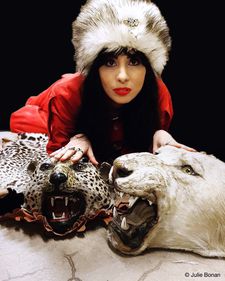 |
| Filmmaker Aurélia Mengin Photo: Julie Bonan |
Aurélia MenginMy career is truly atypical and strewn with challenges. Being a woman from Reunion Island makes it much more difficult to enter the world of cinema and it was even more difficult when I started my career 20 years ago. Even after having made 8 shorts and 2 feature films, it is very complicated to meet producers in France, because the cinema environment in France is very closed. People like to keep to themselves and are not very curious about what is comes from elsewhere, and even less from the French islands. In addition, my films destabilise a lot of producers and distributors in France and those in Reunion Island, because my aesthetic universe and the stories that I tell and that I shoot do not correspond at all to the image that people have, of what an island woman director should be.
What is surprising and invigorating is that since my first shorts my films have always been particularly well received by international festivals and the foreign press. Unlike the world of cinema in France, internationally, my Reunionese origin is not a handicap, which takes away my credibility. On the contrary, abroad, my films are selected and seen by cinema lovers and journalists without any prejudice in relation to my origins. So if I am still making films today, it is thanks to my parents. They made me grow up with an amazing strength and determination. They have always encouraged me, since the first day I decided to leave my university studies to make films.
I am self-taught and have never attended a film school, however I attended an acting studio school in Paris for three years, where I learned to act and direct actors. As soon as I left school, my mixed race and physique as a woman from Reunion was a huge obstacle when it came to casting. There was no role for me, so I decided to write and direct my own films and act in all of them.
In the past 20 years, I have directed music videos, around ten short films, then Fornacis and Scarlet Blue. I have never obtained any support for my films from the Regions in Réunion or in France, and no support from the National Cinema Center (CNC). For 20 years, I have fought with all my passion (and my convictions) to deliver each piece of work to date. In France, success is difficult and strewn with trials; even more for a self-made woman from Réunion who produces ‘fantastic’ feminist films.
 |
| Scarlet Blue |
So I self-produced my short films, while my medium length film, Adam Minus Eve, and my first feature Fornacis were made with my parents. They always helped me and participated in each of my shoots. My father, Vincent, always said that we are like a circus family and that we have to help each other. I asked him to build several sets for my films and he was amazing, building exactly what was envisioned in my script. My father also did the behind the scenes documentary, while my mom cooked for the entire film crew. My crew even stayed in my parents’ house because we didn't have the budget to pay for hotels. Without the support and investment of my parents, I would never have been able to complete this journey. The success of each of my films in numerous international festivals has allowed me to still believe in myself and maintain my passion for making movies, and I really hope to find a producer to produce my next feature film.
Despite the low budget, I never give up! I am convinced that my greatest quality is a formidable capacity for work… a true mastery of my visual and aesthetic universe. I can shoot my films in a few days. I shot Fornacis in 13 days and Scarlet Blue in 19.
With Fornacis, the recognition of my films and my directing work in the cinema press and at festivals has significantly accelerated. Fornacis has toured the world in festivals, with more than 30 official selections, and won nine prestigious awards in many countries and in different categories, including a directing award, Best Fantasy Feature Film award, photography, a Female Performance award for the character I play, editing and Originality award. The film was also released on Amazon Prime UK.
Two years ago, I received the Medal for Ultramarine Commitment for my work from the Minister of Overseas in France, to further promote international culture on Reunion Island. This medal has incredible meaning to me and I am proud to be the first woman from Reunion Island to have directed a feature film for cinema… and I am even more proud when I know that I work so hard and that my journey has been so difficult. All these successes and this recognition of my work gave me the strength to write Scarlet Blue and to throw myself into shooting this film.
For Scarlet Blue the adventure was different. For the first time private financiers believed in my work and financed the shooting of the film but they asked me to shoot my film in the Basque Country in France and Spain.
JK: Why did this subject matter appeal to you?
AM: Ever since my first short films and first feature I have explored the presence of the double, twinhood, the ghost and sexuality from a woman's point of view. There is a red line running through my filmography that highlights the confusion between hallucinations, fantasies and reality.
 |
| Scarlet Blue Photo: Aurélia Mengin |
When I was writing this script, I had a very clear idea of two themes that would be the main focus of Scarlet Blue: schizophrenia and hypnosis. I also knew that I wanted to treat schizophrenia not in the classic way, such as in a hospital, but, instead, use schizophrenia as a gateway to surrealism… as the purest expression of imagination and creation. I also knew from the start what Scarlet Blue would have as a backdrop, in this complex mother-daughter relationship that we find between the character of Alter and her mother, Rosy.
During the writing, in the back of my mind I had teenage memories of one of my best friend’s first schizophrenic attacks when she was around 16 years old. For several years she lived through terrifying and violent experiences and, misunderstood, she was plunged into great suffering and also partial amnesia. The doctors were powerless at the time and those around her also somewhat disarmed. I tried to transcribe in my ‘artistic universe’ the violence of the mental illness from which the character of Alter suffers; her solitude, her absences and her losses of connection to reality, and the helplessness of her mother Rosy.
I discovered very late, about six years ago, that I had Asperger's syndrome. Since my childhood, I suffered a lot from bullying at school due to the fact that other children thought I was strange, which then led to violence against myself even as an adult, because I was ‘different’. This makes me feel very close to Alter's character, because in the film, Alter suffers from her differences. Scarlet Blue is a declaration of love to all people suffering from exclusion.
JK: How did you coordinate the performances of the two different actresses playing Alter?
AM: During the preparation of my shoot, I had to cast two actresses looking identical to play twin sisters. The character of Alter is also played by two actresses throughout the film. And these actresses also had to resemble Patricia Barzyk, their mother in the story. So it was a really difficult cast to find!
Alter is a single character worn by two actresses, who have such a disturbing resemblance in their faces and bodies, that once they are in make-up and in costume it is almost impossible to tell them apart. In that regard, I think the performance is very successful!
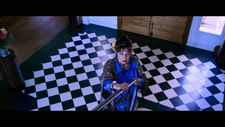 |
| Scarlet Blue Photo: Aurélia Mengin |
To bring schizophrenia and the split personality to life, I approached the character of Alter under two very different facets: the first facet represents Alter when she is connected to reality; the whole realistic part of the character, which is performed by Amélie Daure. The 2nd facet represents the schizophrenic double, that is to say all the sequences where Alter is experiencing hallucinatory crises, carnal impulses, nightmares, and all the sequences involving insanity. This borderline facet of Alter's character is played by Anne-Sophie Charron.
Before the shoot, I did not know exactly how many sequences of Alter would be played by each actress, but from the beginning I knew that Amélie Daure would play the reality part and Anne-Sophie Charron the schizophrenia part.
Addressing schizophrenia in this way makes it possible to naturally and viscerally create the inner fracture of the character of Alter, thus making it possible to truly touch the syndrome of memory loss and personality dissociation.
With this approach of sharing the character of Alter between actresses, we truly touch on a sort of ‘mise en abîme’ of schizophrenia, because like Alter, the actress Amélie Daure cannot remember the episodes of the schizophrenic crises that the character goes through, because she did not experience them… since it was the actress Anne-Sophie Charron who was immersed in those moments.
The casting happened naturally because Amélie and Anne-Sophie have very different approaches to acting. Amélie comes from a more realist background and was not at all familiar with the fantastic, surreal, aesthetic and organic approach of my filmmaking; the world of Scarlet Blue is very far away from what she was used to. So, she approached the character of Alter not so much with her body but in a more cerebral way. For all these reasons, we worked with her on Alter's mental state; on the closed body and face; the lack of communication as she played the character when connected to reality.
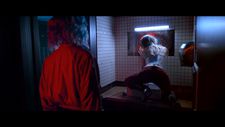 |
| Scarlet Blue Photo: Aurélia Mengin |
I met Anne-Sophie for the casting of Fornacis, and although I didn’t choose her for a role, I was convinced that I would work with her on another project. I was really connected with her and the relationship she has with acting, which she approaches instinctively and physically with her body.
I explained all about this complex approach I had and playing a character who only speaks with her body and who has no dialogue but a lot of nudity and sexuality. I explained how she would have to act in all the sequences of madness, fantasy and desires… that her main costume would be her own skin.
It was crucial she felt capable of shooting her nude sequences, because the body and thwarted phantasmagorical femininity are at the centre of the film.
Throughout the filming, I was carried by Anne-Sophie's confidence and impressed by her freedom of play and her control of the body and totally letting go. She is an incredible actress, who, on set, follows her instincts. She is powerful and deeply human and humble. She managed to absolutely embody the schizophrenic part of Alter's character and all of the madness and sexual impulses. There is this naturalness, spontaneity and strength in each of her sequences which were really not that easy to shoot, thus giving a real life to schizophrenia shaped by the imaginary and nightmarish world of Alter. Anne-Sophie also had this incredible humility to agree to play this mute side of the character, and through her humility she was able to deeply embody the mental illness. She also plays the fish woman, this sort of ghost who follows Alter during the film, and, without hesitation, she ate a huge raw fish for two major sequences in the film.
JK: What was it like directing the film and starring in it at the same time?
AM: After six years of studying mathematics and economy at the University of Réunion and the Sorbonne University of Paris, I decided to quit mathematics to attend an acting school for three years. I learned acting and directing actors for theatre, with classic authors like Shakespeare, Chekov, Racine and his Greek tragedy…I began as an actress and as soon as I finished the acting studio school, I began writing and directing music videos, then shorts, medium length and finally feature films. As I did not go to a director's movie school, I learnt by myself by making my own films.
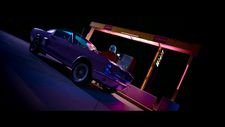 |
| Scarlet Blue Photo: Aurélia Mengin |
I am an actress and so in each of my scripts I tend to write for myself. I take immense pleasure in playing the characters in my films and I also find it essential to engage with both my image and my body in my films. I approach each film as a total work of art in which I perform in the world I create. My films revolve a lot around madness, desire, nudity, bodies... and exposing my own body also allows me to feel united in taking risks with other actresses and actors. Especially with this film, where sexuality occupies an important place in the organic approach to schizophrenia, I wanted to engage my body as intensely as the physical engagement that I asked of my actress Anne-Sophie Charron. We were each other’s safety net.
JK: The colour coding in the film is cleverly built into the landscape (such as the illuminated ceiling panels) and the choice of key objects (such as the car). How did you develop this aspect of the production?
AM: Since my first short films, the strong use of colour has been omnipresent in my work. Colour is a central element in my films, not only in the lighting, but also the costumes, sets and makeup. When it comes to other objects, I have been fascinated by vintage cars since I was a child and have made reference ever since I shot my first short films featuring old American and French cars from the Sixties and Seventies. In fact, I collect strange and vintage objects.
The sets, accessories and cars occupy a particular place in my work and so those important choices validate each object brought to the screen. The sets and each accessory are active characters in the film's narrative.
I stage the sets and all of the design and props of the film with the same intensity and the same rigour with which I stage the actors. I am convinced that the actors, the costumes, the make-up, the light, the sets and the objects are part of a whole unity that must be filmed with permanence (like magma), otherwise we miss the true experience and immersive nature of cinema. Framing and movement is also a crucial part of my films. Providing such strict artistic direction on my films guarantees a fusion of all the components of the film.
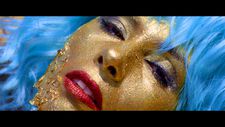 |
| Scarlet Blue Photo: Aurélia Mengin |
From the writing stage I plan the aesthetic with precision, which includes the choice of each object, each costume, each car, the fabric, tapestry, cup… all these elements must fit together perfectly to create the final look of the film. While writing I set out to use these two integral colours of blue and red, which are obviously the very essence of the film.
Blue symbolises truth, healing, forgiveness and serenity. Red symbolises fear, lies, schizophrenia, sexuality… and the difficulty was to successfully navigate and explore the entire spectrum and shades of these colours throughout the film with their symbolism. Ultimately, I wanted to succeed in mixing these two strong primary colours throughout, without one overpowering the other, finding balance and harmony.
The writing of the scenario is very detailed. The sets, costumes and lighting are widely described, as well as the camera movements. During the writing I created a bible focussed on the aesthetics, which brought together around 500 reference photos of sets, fabric, materials, paint, hairstyles and cars. This bible accompanied me when preparing the film and throughout production, allowing me to construct and communicate this world to everyone involved.
My work is truly personal and I have been building my narrative, aesthetic and my colour palette for the past 20 years. I believe that Scarlet Blue is a true accomplishment of all the years of work and research that I have put into each film. I approach cinema as a field of intimate research, and I pursue an approach to filmmaking similar to the one I had at university with mathematics. What I mean by this is that my goal is to question cinema; to create; to attempt and experience new things… both narratively and aesthetically, through visuals, light, framing and sound. I want to find my own cinematic language that displays humanity in all its passion and pain. I love human beings, especially those whom life has jostled and crushed; who have suffered but found healing. I am hoping my films speak of the struggle to choose life… rather than death.
JK: The film takes an erotic perspective on its female subjects but feels very far from the traditional male gaze. How did you going about making that aspect of the film work differently?
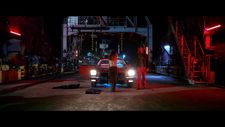 |
| Scarlet Blue Photo: Aurélia Mengin |
AM: For almost 20 years, I have been exploring different aspects, different issues, of the body(s), of the sexuality(ies), through my films but also in my work as a photographer. I use the body as organic material to sculpt and cover with colour, like a white canvas which suddenly bursts into flames. I only take a feminine artistic look at bodies. I believe that it is this approach, deeply guided and sanctified by art, which allows me to approach nudity and sexuality head-on without ever falling into vulgarity or eroticism. I respect the fragility of bodies far too much to insult them with vulgarity. My goal and my challenge is to access the intimate in an extravagant and extroverted way without ever crossing the mirror of voyeurism.
As for the female gaze, I am a woman, and before being a woman, I was a tomboyish little girl, then a very self-conscious teenager and a young woman lost in the middle of all the male gaze road signs that society imposes on us. When I started writing and directing my films I had a devouring obsession to succeed in talking about women and also men, their fragilities, their wounds, their desires and their sexuality, always through a female gaze... .20 years ago I was considered a kind of outsider – sometimes even worse, like a monster. Today my approach is spreading everywhere and people are talking more and more about female gaze.
JK: How did you go about addressing the hypersexuality that schizophrenic people can experience whilst avoiding judgement?
AM: Whenever I make a film, I never judge the story or the behaviour of the characters. I love each of the characters in my films. If I judge, I will never be able to tell stories or make films. As a filmmaker, my job is to tell the world through my eyes and I focus on exposing humanity and human beings in their magnificent originality and diversity.
Judgements are gangrene and the death of art and free thought. Drawing and embodying schizophrenia requires writing and filming with sincerity and kindness and with absolute freedom.
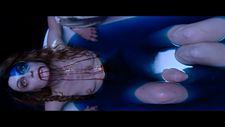 |
| Scarlet Blue Photo: Aurélia Mengin |
Scarlet Blue is a dive into the bowels of a body and a brain suffering from depression, schizophrenia and sexuality disorder. I literally stripped myself bare to make a sincere, authentic and uncompromising film. I wanted to make a film that was as powerful and as violent as this mental illness… incandescent and cruel at the same time.
From the writing of the screenplay, my challenge was to stage the terrifying and phantasmagorical imaginary world that the character of Alter experiences during her crises and during her hypnosis sessions. The hallucinatory visions that punctuate Scarlet Blue are, for me, the real power of the film… as if surrealism devoured reality.
I tried my best to experience and film schizophrenia from the inside without shame or censorship. I wanted to capture the tortured soul, the chaos of bodies, the desires, sexuality, the wanderings, the solitudes, the silences and the fragilities.
JK: Why did you choose to have the therapy conducted in such an unusual environment? it seemed to me like a womb-like space.
AM: I grew up in the town of the Piton de La Fournaise volcano in Reunion Island. This volcano is the most active in the world.
I wanted to create a magical place, which looks like underground volcanic caves and also which reminds me of the mysterious places where my mother took me to consult prayer healers when I was a child. Reunion is a land of rites and mystical beliefs. It was very important to stage the captivating character of the healer Leandro Lecreulx in a strange place which reinforces the masterful interpretation of the Italian actor Stefano Cassetti. I had not thought that this could make one think of the inside of the maternal womb, but this analysis pleases me very much, and goes completely into the psychology and symbolism of Scarlet Blue, because for one of the settings of the nightmare, the sequence where Alter is locked in a net cocoon surrounded by terrifying dolls, I thought of this setting as a mother's womb full of aborted babies.
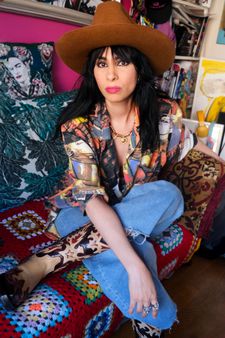 |
| Aurélia Mengin Photo: courtesy of Aurélia Mengin |
JK: How did you develop the character of the mother? She seems very different from the others because she's the only one who knows the secret that has shaped Alter's life.
AM: The first actress I chose was Patricia Barzyk who magnificently plays the role of Rosy, Alter's invasive and mysterious mother.
Rosy is the only character who is anchored in reality. She is the only one who, from the beginning of the film, knows the whole truth about Alter's troubled and terrifying past. Patricia Barzyk, upon reading the script, fell completely in love with this character of Rosy. She immediately managed to project herself into this loving but also stifling and ambiguous mother. Together, we discussed the character of the mother a lot before filming, and my priority was to achieve what we fully feel throughout the film: the excessive love that Rosy has for her daughter Alter, because it is this unconditional maternal love which then allows the audience to accept and forgive the film's final reveal.
Patricia was really impressive in her interpretation of Rosy because she managed to nourish the character with an extravagant frivolity and a deep inner pain which shows through immediately in the film and which gradually nourishes the weight of the secret that devours Rosy and Alter.
JK: How do you feel about the film screening at Frightfest?
AM: For me, the selection of Scarlet Blue at Frightfest is a huge honour and also a wonderful validation of my work as a director. I'm really proud to be screened for the first time in this festival, which is one of the most famous fantastic film festivals in the world. This selection fills my heart with joy and I warmly thank the directors of the festival for believing in my film and giving it so much light!
JK: What are your filmmaking ambitions now?
AM: I am looking for French or foreign producers for my third feature film. I very much hope that the positive and enthusiastic feedback on Scarlet Blue at festivals and in the press will help me meet producers to finance my next film.





















